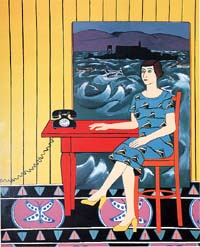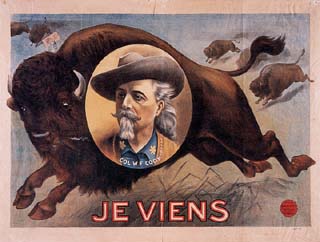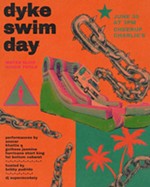Coffee Table Books That Depict and Provide Escape From
By Clay Smith, Fri., Dec. 18, 1998
|
|
Since objectivity is pointless, really pointless, when it comes to coffee table books, why not throw it out the window with a hearty heave-ho? When I think about coffee table books, I think about a remark philosopher Ludwig Wittgenstein made in a notebook in 1937: "The horrors of hell can be experienced within a single day; that's plenty of time." Wittgenstein probably wasn't thinking of coffee table books when he wrote that, but who knows ñ he may have been. Maybe the day he wrote that line he was forced to sit down with something like The Book of Twins: A Celebration in Words and Pictures, in which the following sentence does actually appear: "There was just no stopping the speedy Gassman twins." He probably tired of those droning, blatantly informational passages so endemic to coffee table books, exemplified in spades in Sara Rath's The Complete Cow: An Udderly Entertaining History of Dairy & Beef Cows of the World ("Today, the cattle found in Uganda, Rwanda, and Burundi are particularly notable, and possess different names"). Even though most coffee table books end up on coffee tables and stay there, rarely bothered by human hands, they are deeply felt purchases because of their often inhibiting price. And they are deeply felt purchases because of their visual splendor ñ the best coffee table books offer whole, enticing worlds to discover that the buyer may know only something or even next to nothing about. Worlds that can be revisited over and over again. Usually, it's a sad fate for even those coffee table books, though; they offer such a rich escape and they end up displayed like inert trophies.
|
|
The Journey Is the Destination: The Journals of Dan Eldon ($27.50 hard) is another atypical coffee table book, also a montage of sorts. Unlike Bordertown, this book's violence is subtle because the real violence connected to its author isn't represented by him; it happened to him. Dan Eldon was a Reuters photographer stoned to death in 1993 by a mob in Somalia reacting to a United Nations bombing raid on the suspected headquarters of General Mohammed Farah Aidid. Eldon's mother, Kathy Eldon, opens The Journey by relating those facts; she laments Eldon's early death at the age of 22, by which time "he had already achieved prominence for his work as a war photographer. But his photographs told only half the story. The other half lay hidden away in seventeen black-bound journals filled with collages, writings, drawings, and photographs." I'm afraid I wouldn't recognize a Reuters war photograph by Dan Eldon if it hit me in the face, but his other artistic life exhibited in The Journey is thoroughly intriguing and worth returning to over and over. His friends and the trips he took feature prominently, but ruling all that is a kind of random, stuck-together feel to the book that indicates Eldon's wild imagination and determination to pursue whatever appealed to him. There are no organizing aesthetic principles in The Journey ñ the book's creators seem to have let out a robust Hallelujah! in recognition of that fact.
Art: A World History (DK Publishing, $59.95 hard) is very well-organized and comprehensive, with brief, snapshot-like forays into all the major periods and movements, but it's too much, too fast. The chapter on Byzantine art, for example, has one summary article that weaves throughout sidebars on topics like "Armenian Architecture," "Coptic Art," and "Anonymous Master: 'Jesus of Nazareth as Christus Imperator.'" Here's a holiday game idea: Take Art: A World History, gather round friends and family, open this tome to any particular page, and point to an artwork ñ whoever names its correct title first wins. Doesn't that sound like fun? This game can be played in teams or individually.
Two art books more likely to be used, however, are Maya (Rizzoli, $85 hard), and Art and Architecture of Spain (Bulfinch, $125 hard), books that limit themselves, majestically, to specific cultures. The articles that accompany the beautifully printed art in Art and Architecture of Spain are academic but accessible; at just under 600 pages, it covers, its creators say, 30,000 years of artistic work "in the fields of painting, sculpture, architecture, and applied arts, focusing on masterworks and the major artistic personalities of each period." It's the kind of art book that is the master text on the subject matter. Maya also formidably conquers its subject matter, and is just as finely formatted as The Art and Architecture of Spain. If only because of the subject matter, it's a more raw, otherworldly, and visceral book ñ one caption states, "effigy vessel representing a turtle with human face emerging from its mouth and seated human figure on its head, Mayapan, Yucatan, Late Postclassic period," and that's not that unusual for Maya.
|
|
It's a bit embarrassing to say that Street Posters & Ballads: A Selection of Poems, Songs & Graphics by Eric Drooker (Seven Stories Press, $18 paper) is a testament to fighting the good fight, because his art is more hard-edged than that feel-good statement implies. In an afterward to the book, Allen Ginsberg relates his history with Drooker, who illustrated Ginsberg's poem "The Lion for Real": "I first glimpsed Eric Drooker's odd name on posters pasted on fire-alarm sides, construction walls checkered with advertisements, & lamppost junction boxes in the vortex or Lower East Side Avenues leading to Tompkins Square Park, where radical social dislocation mixed homeless plastic tents with Wigstock transvestite dress-up anniversaries." That's the origin of Drooker's block print art, which depicts police brutality and racial injustice, but not without heart. One non-political story, "The Fall," tells the tale of Douglas Winchester, "legendary throughout Brooklyn for his irreverent attitude & wild behavior," who takes his bulldog Mugsy everywhere with him, even after Mugsy falls through a crack in the Brooklyn Bridge and dies. Winchester somehow retrieves Mugsy and takes him to a party that night "tearfully lamenting" Mugsy's death but all the while "using the dog's body as a theatrical prop." At the end of "The Fall" Winchester himself dies due to falling out a window. The horrors of hell indeed.
There are many revealing and charming images in the Buffalo Bill's Wild West: An American Legend by R.L. Wilson with Greg Martin (Random House, $60 hard), but by far the most entertaining is a poster made for one of Buffalo Bill's appearances in France in the early 20th century. Buffalo race through the plains while in the middle of the poster is Buffalo Bill with the words "Col W.F. Cody" in small print below his head. But in large print below Buffalo Bill's image are the words "Je Viens" ñ "I am coming" ñ all the words that were needed to announce the arrival of Buffalo Bill. The entire Buffalo Bill posse is present in this exhaustive book, but particularly engaging is the inclusion of Annie Oakley and the story of Oakley versus William Randolph Hearst. In Hearst's Chicago Examiner and Chicago American in August 1903, stories were printed "that claimed that Oakley had become a cocaine addict and destitute and was serving a jail term for theft!" Apologies and retractions were printed since the stories were based on an Oakley imposter, but Oakley, it seems, never forgave the media beasts: "That terrible piece ... nearly killed me. ... The only thing that kept me alive was the desire to purge my character."
|
|
I imagine The Simon & Schuster Encyclopedia of Animals: A Visual Who's Who of the World's Creatures ($50 hard) is intended for children or anyone who desires comprehensive knowledge of all the world's creatures. A chapter on bats is titled "Funnel-eared, Smoky, Disc-Winged, Sucker-footed and Short-tailed Bats." Each bat, and every animal in this book, is drawn in colored pencil with facts galore about each of them. The short-tailed bat, for example, "has a thick mustache fringing its small mouth. Each bristle of the mustache has a spoon-shaped tip." That's just the kind of detail that makes children cringe with delight; it's the kind of detail only adults could pretend to really care about. Chronicle Books' Borneo Rain Forest by Mattias Klum ($24.95 paper) is refreshingly unclear about animals, unclear in the sense that Klum tends to focus on only part of a snake or a glimpse of an orangutan. That technique perfectly reveals the nature of the Borneo rain forest, where things are rarely what they seem, just like they are in the best coffee table books.












